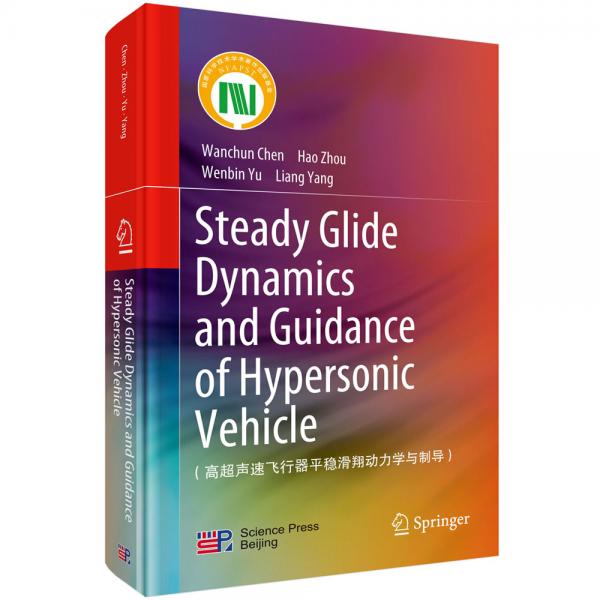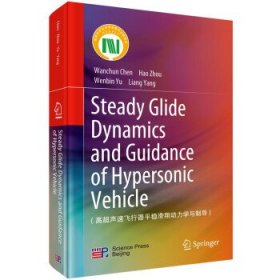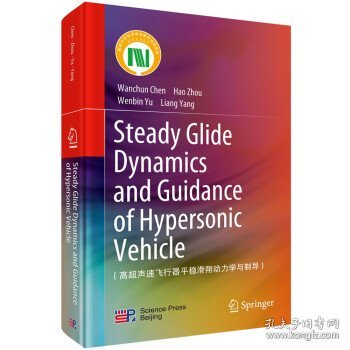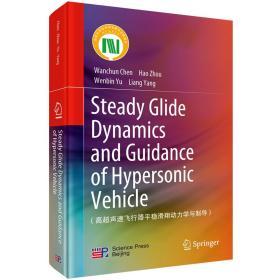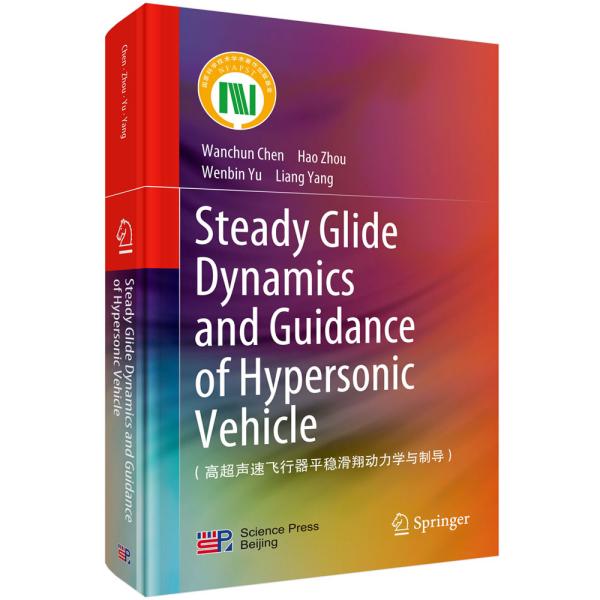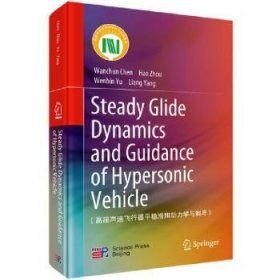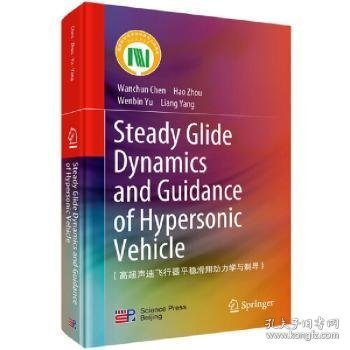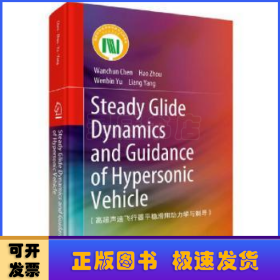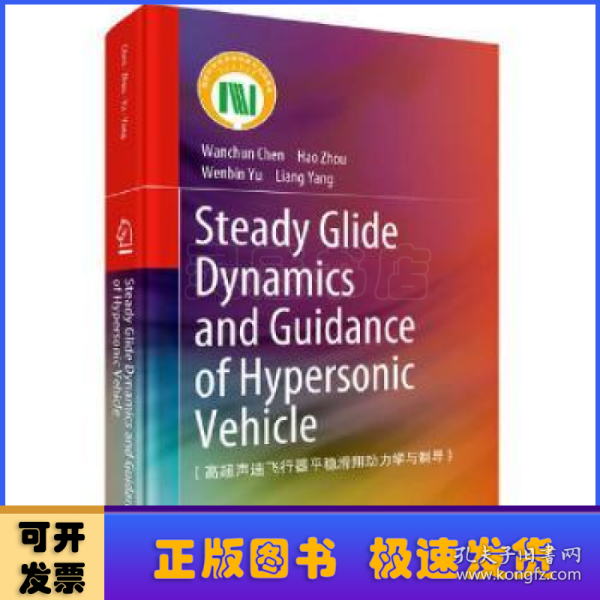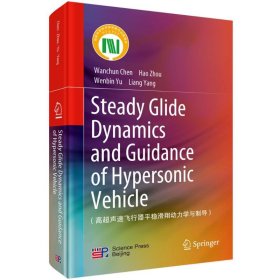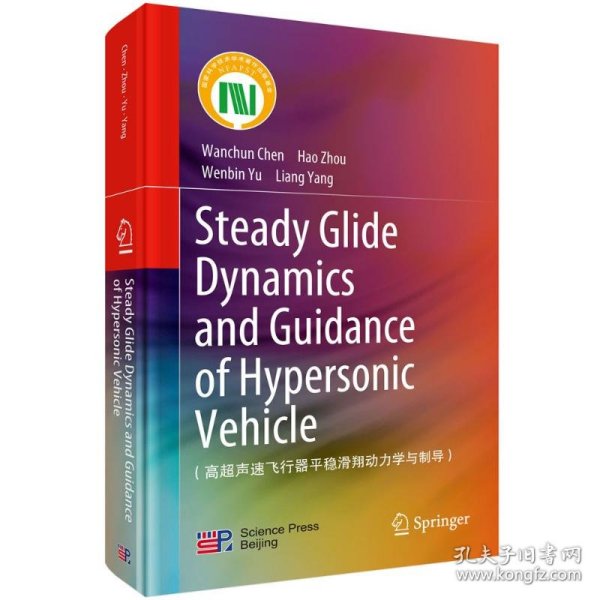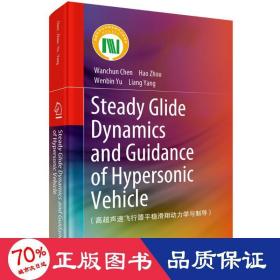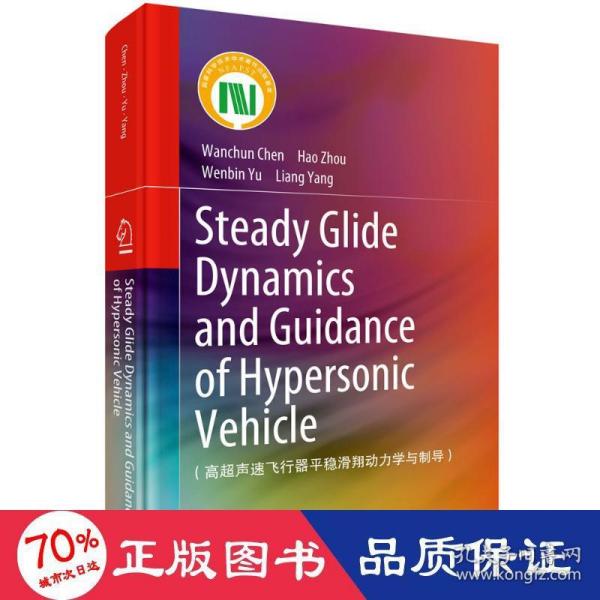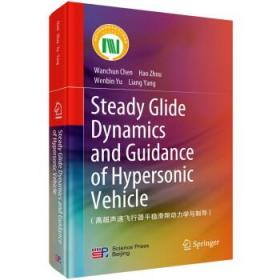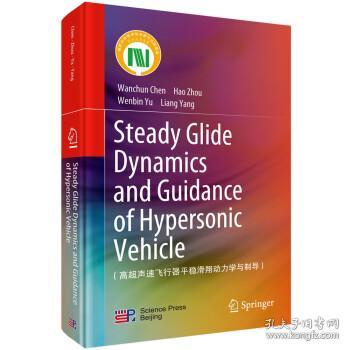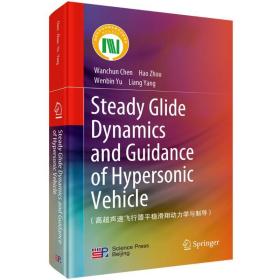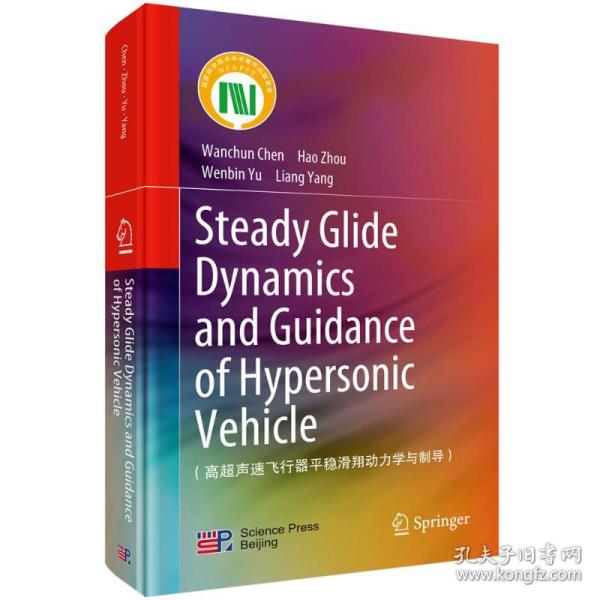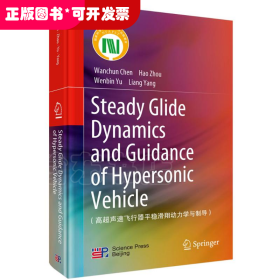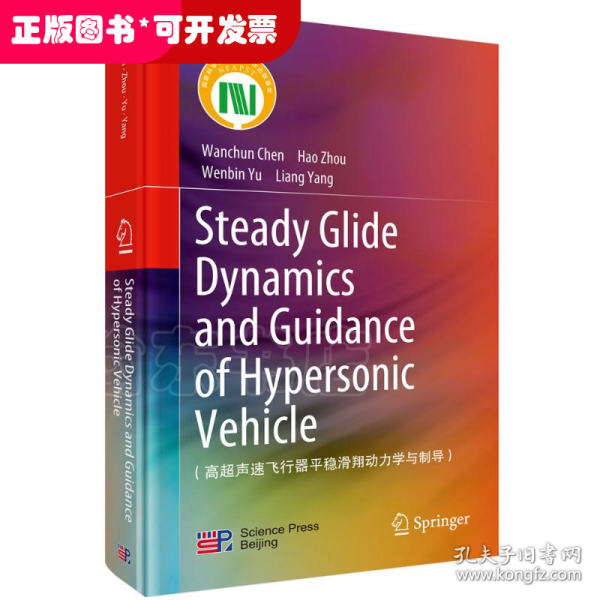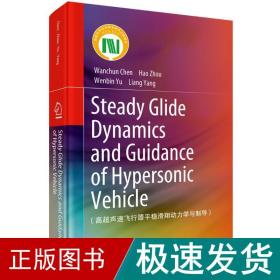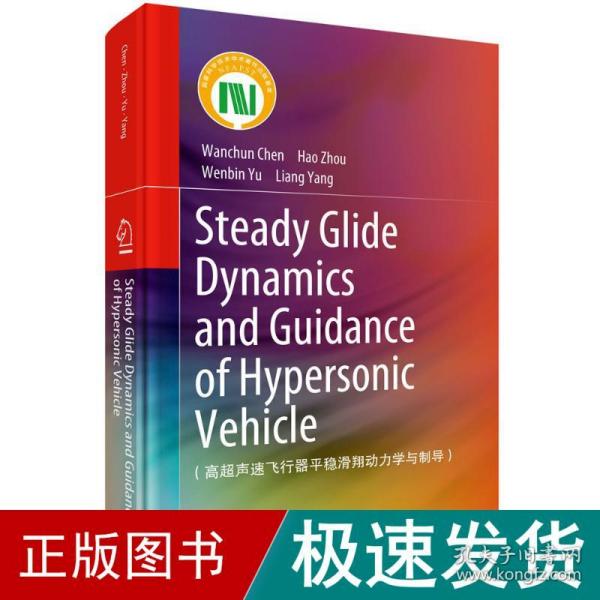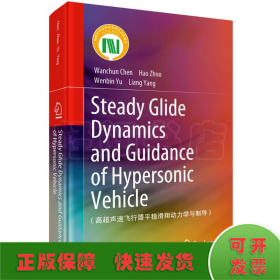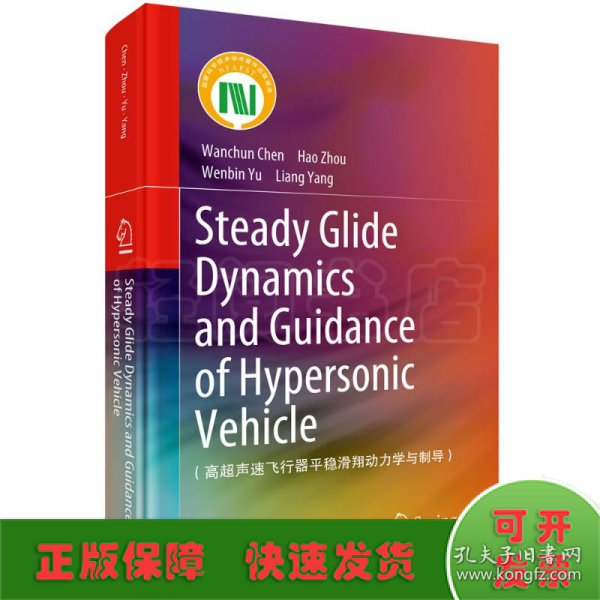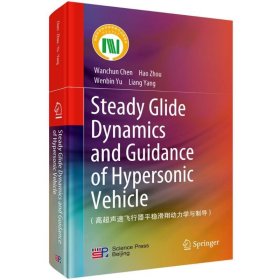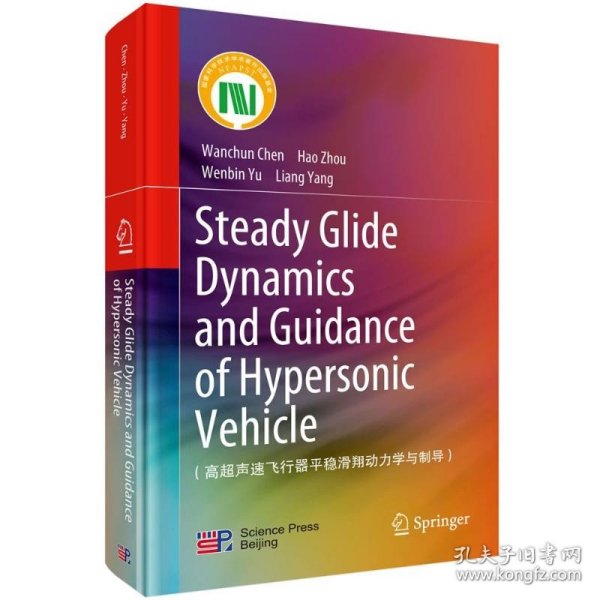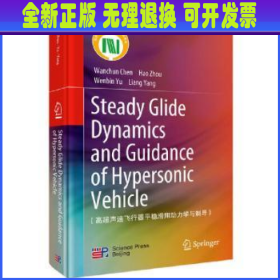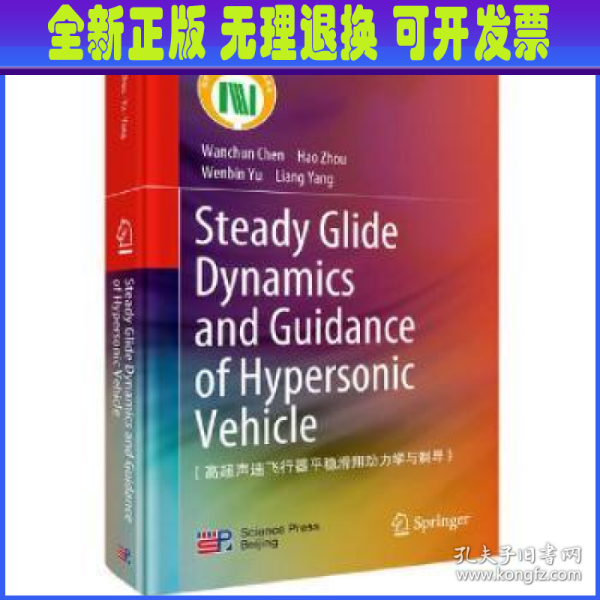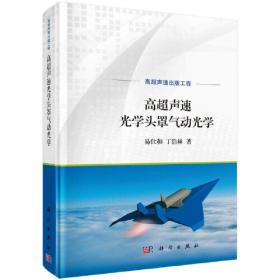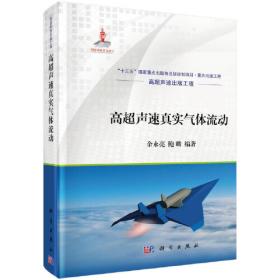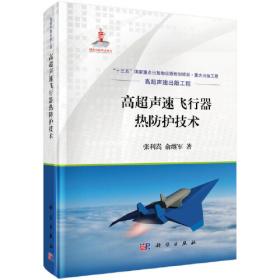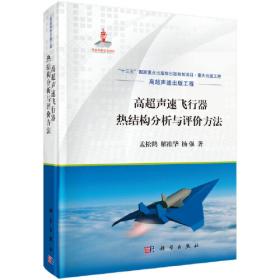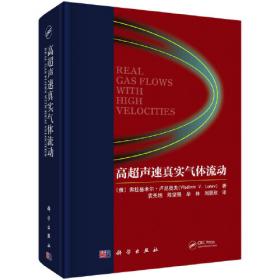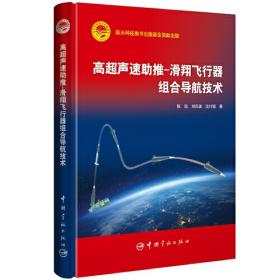高超声速飞行器平稳滑翔动力学与制导(英文版)
出版时间:
2022-03
版次:
1
ISBN:
9787030716378
定价:
280.00
装帧:
精装
开本:
16开
纸张:
胶版纸
页数:
461页
1人买过
-
高超声速飞行器具有航程远、飞行快、临近空间飞行、不易探测、机动能力强等优点,但由于再入速度快带来了高热流、末端制导精度不易满足等问题,为了克服这些问题,研究多过程约束和末端约束的制导技术至关重要,《高超声速飞行器平稳滑翔动力学与制导(英)》是以此背景而著。
《高超声速飞行器平稳滑翔动力学与制导(英)》从平稳滑翔的概念和基本理论-运动学、动力学和控制方程-平稳滑翔弹道的动态特性-平稳滑翔弹道的设计-基于平稳滑翔理论的制导方法全面系统地介绍高超声速飞行器再入平稳机动滑翔动力学与制导技术,在理论深度和应用参考性方面有自己的特色。 主要内容包括:平稳滑翔再入动力学模型;平稳滑翔弹道动态特性;弹道阻尼控制技术;基于平稳滑翔的弹道优化技术;基于平稳滑翔的线性伪谱广义标控脱靶量制导;平稳滑翔弹道解析解;平稳机动滑翔突防弹道设计。 Contents
1 Introduction 1
1.1 Problem Description 1
1.2 Research Significance 2
1.3 Research Progress 4
References 8
2 Mathematical Fundamentals 11
2.1 Regular Perturbation Method 11
2.2 Singular Perturbation Method 13
2.3 Spectral Decomposition Method 16
2.3.1 Idempotent Matrix 16
2.3.2 Spectral Decomposition Theorem 16
2.3.3 Inference 17
2.3.4 Example 19
2.4 Pseudospectral Method 19
2.4.1 Introduction of Method 19
2.4.2 Pseudospectral Discrete Process 23
2.5 Linear Gauss Pseudospectral Model Predictive Control 33
References 38
3 Mathematical Modeling for Hypersonic Glide Problem 41
3.1 The Coordinate System Adopted in This Book 41
3.1.1 Geocentric Inertial Coordinate System (I) 41
3.1.2 Geographic Coordinate System (T) 41
3.1.3 Orientation Coordinate System (O) 42
3.1.4 Velocity Coordinate System (V) 42
3.1.5 Half-Velocity Coordinate System (H) 42
3.1.6 Body Coordinate System (B) 43
3.2 Transformation Between Coordinate Systems 43
3.2.1 Transformation Between the Orientation Coordinate System and the Half-Velocity Coordinate System 43
3.2.2 Transformation Between the Velocity Coordinate System and the Half-Velocity Coordinate System 43
3.2.3 Transformation Between the Velocity Coordinate System and the Body Coordinate System 44
3.2.4 Transformation Between the Body Coordinate System and the Half-Velocity Coordinate System 45
3.3 Dynamic Equations of Hypersonic Vehicle in Half-Velocity Coordinate System 45
3.3.1 Dynamics Equations of the Center of Mass in Half-Velocity Coordinate System 45
3.3.2 The Dynamic Equations of the Center of Mass of the Vehicle 48
3.3.3 Dynamic Equations of Hypersonic Gliding Vehicle Based on BTT Control 48
3.3.4 Dynamic Equations of Hypersonic Vehicle in Vertical Plane 49
3.3.5 Atmospheric Model 50
3.3.6 Aerodynamic Model 50
3.3.7 The Stagnation Point Heat Flow,Overload and Dynamic Pressure 50
4 Mathematical Description of Glide-Trajectory Optimization Problem 53
4.1 Mathematical Description for Optimal Control Problem 53
4.1.1 Performance Index of Optimal Control Problem 53
4.1.2 Description of Optimal Control Problem 54
4.1.3 The Minimum Principle 55
4.1.4 Final Value Performance Index of Time-Invariant Systems 56
4.1.5 Integral Performance Index of Time-Invariant Systems 57
4.1.6 Optimal Control Problem with Inequality Constraints 58
4.1.7 Methods for Solving Optimal Control Problems 58
4.2 Mathematical Description of Optimal Control Problem for Hypersonic Vehicle Entry Glide 61
4.2.1 Maximum Final Speed Problem 61
4.2.2 Maximum Range Problem 62
4.2.3 Shortest Time Problem 62
4.2.4 Optimal Trajectory Problem with Heating Rate Constraint 63
4.2.5 Optimal Trajectory Problem with Heating Rate and Load Factor Constraints 64
5 Indirect Approach to the Optimal Glide Trajectory Problem 65
5.1 Combined Optimization Strategy for Solving the Optimal Gliding Trajectory of Hypersonic Aircraft 67
5.1.1 Mathematical Model of Hypersonic Gliding 67
5.1.2 Necessary Conditions for Optimal Gliding Trajectory 68
5.1.3 Solving Two-Point Boundary Value Problem by Combination Optimization Strategy 69
5.1.4 Numerical Calculation Results 70
5.1.5 Conclusion 73
5.2 Trajectory Optimization of Transition Section of Gliding Hypersonic Flight Vehicle 74
5.2.1 Aerodynamic Data for the Transition Section 74
5.2.2 Unconstrained Trajectory of Maximum Terminal Velocity 75
5.2.3 Heat Flow Constrained Trajectory of Maximum Terminal Velocity 76
5.2.4 Solving the Two-Point Boundary Value Problem for the Transition Section 77
5.2.5 Optimizing the Transition Trajectory with Direct Method 77
5.2.6 Steps for Solving the Optimal Transition Trajectory 78
5.2.7 Transitional Trajectory Obtained by Indirect Method 81
5.3 The Maximum Range Gliding Trajectory of the Hypersonic Aircraft 84
5.3.1 Guess Initial Values for Optimal Control Problem by Direct Method 84
5.3.2 Indirect Method for Solving Optimal Control Problems 89
5.3.3 The Maximum Range Gliding Trajectory of the Hypersonic Aircraft 94
References 101
6 Direct Method for Gliding Trajectory Optimization Problem 103
6.1 Direct Method for Solving Optimal Control Problems 103
6.2 Direct Shooting Method 104
6.2.1 Direct Multiple Shooting Method 104
6.2.2 Direct Method of Discrete Control 105
6.2.3 Gradual Subdividing Optimization Strategy 106
6.3 Direct Collocation Method 107
6.3.1 General Form of Direct Collocation Method 107
6.3.2 Direct Transcription 108
6.3.3 Implicit Integral Method 109
6.3.4 Solving Optimal Trajectory Problems with NLP 110
6.4 Direct Collocating Method for Trajectory with Maximum Gliding Cross Range of Hypersonic Aircraft 111
6.4.1 Mathematical Model 111
6.4.2 Re-entry Flight Control Law with Given Angle of Attack Profile 113
6.4.3 Solution of Maximum Cross Range Problem by Direct Colloca
-
内容简介:
高超声速飞行器具有航程远、飞行快、临近空间飞行、不易探测、机动能力强等优点,但由于再入速度快带来了高热流、末端制导精度不易满足等问题,为了克服这些问题,研究多过程约束和末端约束的制导技术至关重要,《高超声速飞行器平稳滑翔动力学与制导(英)》是以此背景而著。
《高超声速飞行器平稳滑翔动力学与制导(英)》从平稳滑翔的概念和基本理论-运动学、动力学和控制方程-平稳滑翔弹道的动态特性-平稳滑翔弹道的设计-基于平稳滑翔理论的制导方法全面系统地介绍高超声速飞行器再入平稳机动滑翔动力学与制导技术,在理论深度和应用参考性方面有自己的特色。 主要内容包括:平稳滑翔再入动力学模型;平稳滑翔弹道动态特性;弹道阻尼控制技术;基于平稳滑翔的弹道优化技术;基于平稳滑翔的线性伪谱广义标控脱靶量制导;平稳滑翔弹道解析解;平稳机动滑翔突防弹道设计。
-
目录:
Contents
1 Introduction 1
1.1 Problem Description 1
1.2 Research Significance 2
1.3 Research Progress 4
References 8
2 Mathematical Fundamentals 11
2.1 Regular Perturbation Method 11
2.2 Singular Perturbation Method 13
2.3 Spectral Decomposition Method 16
2.3.1 Idempotent Matrix 16
2.3.2 Spectral Decomposition Theorem 16
2.3.3 Inference 17
2.3.4 Example 19
2.4 Pseudospectral Method 19
2.4.1 Introduction of Method 19
2.4.2 Pseudospectral Discrete Process 23
2.5 Linear Gauss Pseudospectral Model Predictive Control 33
References 38
3 Mathematical Modeling for Hypersonic Glide Problem 41
3.1 The Coordinate System Adopted in This Book 41
3.1.1 Geocentric Inertial Coordinate System (I) 41
3.1.2 Geographic Coordinate System (T) 41
3.1.3 Orientation Coordinate System (O) 42
3.1.4 Velocity Coordinate System (V) 42
3.1.5 Half-Velocity Coordinate System (H) 42
3.1.6 Body Coordinate System (B) 43
3.2 Transformation Between Coordinate Systems 43
3.2.1 Transformation Between the Orientation Coordinate System and the Half-Velocity Coordinate System 43
3.2.2 Transformation Between the Velocity Coordinate System and the Half-Velocity Coordinate System 43
3.2.3 Transformation Between the Velocity Coordinate System and the Body Coordinate System 44
3.2.4 Transformation Between the Body Coordinate System and the Half-Velocity Coordinate System 45
3.3 Dynamic Equations of Hypersonic Vehicle in Half-Velocity Coordinate System 45
3.3.1 Dynamics Equations of the Center of Mass in Half-Velocity Coordinate System 45
3.3.2 The Dynamic Equations of the Center of Mass of the Vehicle 48
3.3.3 Dynamic Equations of Hypersonic Gliding Vehicle Based on BTT Control 48
3.3.4 Dynamic Equations of Hypersonic Vehicle in Vertical Plane 49
3.3.5 Atmospheric Model 50
3.3.6 Aerodynamic Model 50
3.3.7 The Stagnation Point Heat Flow,Overload and Dynamic Pressure 50
4 Mathematical Description of Glide-Trajectory Optimization Problem 53
4.1 Mathematical Description for Optimal Control Problem 53
4.1.1 Performance Index of Optimal Control Problem 53
4.1.2 Description of Optimal Control Problem 54
4.1.3 The Minimum Principle 55
4.1.4 Final Value Performance Index of Time-Invariant Systems 56
4.1.5 Integral Performance Index of Time-Invariant Systems 57
4.1.6 Optimal Control Problem with Inequality Constraints 58
4.1.7 Methods for Solving Optimal Control Problems 58
4.2 Mathematical Description of Optimal Control Problem for Hypersonic Vehicle Entry Glide 61
4.2.1 Maximum Final Speed Problem 61
4.2.2 Maximum Range Problem 62
4.2.3 Shortest Time Problem 62
4.2.4 Optimal Trajectory Problem with Heating Rate Constraint 63
4.2.5 Optimal Trajectory Problem with Heating Rate and Load Factor Constraints 64
5 Indirect Approach to the Optimal Glide Trajectory Problem 65
5.1 Combined Optimization Strategy for Solving the Optimal Gliding Trajectory of Hypersonic Aircraft 67
5.1.1 Mathematical Model of Hypersonic Gliding 67
5.1.2 Necessary Conditions for Optimal Gliding Trajectory 68
5.1.3 Solving Two-Point Boundary Value Problem by Combination Optimization Strategy 69
5.1.4 Numerical Calculation Results 70
5.1.5 Conclusion 73
5.2 Trajectory Optimization of Transition Section of Gliding Hypersonic Flight Vehicle 74
5.2.1 Aerodynamic Data for the Transition Section 74
5.2.2 Unconstrained Trajectory of Maximum Terminal Velocity 75
5.2.3 Heat Flow Constrained Trajectory of Maximum Terminal Velocity 76
5.2.4 Solving the Two-Point Boundary Value Problem for the Transition Section 77
5.2.5 Optimizing the Transition Trajectory with Direct Method 77
5.2.6 Steps for Solving the Optimal Transition Trajectory 78
5.2.7 Transitional Trajectory Obtained by Indirect Method 81
5.3 The Maximum Range Gliding Trajectory of the Hypersonic Aircraft 84
5.3.1 Guess Initial Values for Optimal Control Problem by Direct Method 84
5.3.2 Indirect Method for Solving Optimal Control Problems 89
5.3.3 The Maximum Range Gliding Trajectory of the Hypersonic Aircraft 94
References 101
6 Direct Method for Gliding Trajectory Optimization Problem 103
6.1 Direct Method for Solving Optimal Control Problems 103
6.2 Direct Shooting Method 104
6.2.1 Direct Multiple Shooting Method 104
6.2.2 Direct Method of Discrete Control 105
6.2.3 Gradual Subdividing Optimization Strategy 106
6.3 Direct Collocation Method 107
6.3.1 General Form of Direct Collocation Method 107
6.3.2 Direct Transcription 108
6.3.3 Implicit Integral Method 109
6.3.4 Solving Optimal Trajectory Problems with NLP 110
6.4 Direct Collocating Method for Trajectory with Maximum Gliding Cross Range of Hypersonic Aircraft 111
6.4.1 Mathematical Model 111
6.4.2 Re-entry Flight Control Law with Given Angle of Attack Profile 113
6.4.3 Solution of Maximum Cross Range Problem by Direct Colloca
查看详情
-
全新
北京市丰台区
平均发货7小时
成功完成率91.01%
-
全新
山东省潍坊市
平均发货16小时
成功完成率80.68%
-
全新
北京市朝阳区
平均发货14小时
成功完成率96.08%
-
全新
-
全新
上海市黄浦区
平均发货10小时
成功完成率94.23%
-
全新
北京市朝阳区
平均发货15小时
成功完成率95.27%
-
全新
江苏省无锡市
平均发货21小时
成功完成率87.92%
-
全新
四川省成都市
平均发货7小时
成功完成率98.66%
-
全新
广东省广州市
平均发货18小时
成功完成率86.76%
-
全新
北京市房山区
平均发货11小时
成功完成率91.76%
-
全新
天津市西青区
平均发货14小时
成功完成率90.02%
-
全新
北京市丰台区
平均发货26小时
成功完成率87.06%
-
全新
江苏省南京市
平均发货15小时
成功完成率82.13%
-
全新
北京市通州区
平均发货9小时
成功完成率87.37%
-
全新
山东省泰安市
平均发货8小时
成功完成率90.95%
-
全新
江苏省宿迁市
平均发货21小时
成功完成率87.92%
-
全新
北京市顺义区
平均发货9小时
成功完成率94.02%
-
全新
江苏省无锡市
平均发货14小时
成功完成率94.59%
-
全新
上海市闵行区
平均发货30小时
成功完成率82.24%
-
全新
广东省广州市
平均发货18小时
成功完成率87.61%
-
全新
江苏省南京市
平均发货7小时
成功完成率95.87%
-
全新
江苏省无锡市
平均发货9小时
成功完成率94.27%
-
九五品
北京市东城区
平均发货30小时
成功完成率84.47%
-
全新
湖北省武汉市
平均发货22小时
成功完成率90.05%
-
全新
四川省成都市
平均发货9小时
成功完成率96.54%
-
全新
海南省海口市
平均发货11小时
成功完成率83.68%
-
全新
江苏省无锡市
平均发货8小时
成功完成率96.11%
-
全新
北京市通州区
平均发货9小时
成功完成率89.68%
-
全新
湖北省武汉市
平均发货20小时
成功完成率86.39%
-
全新
河北省保定市
平均发货15小时
成功完成率90.84%
-
全新
江苏省无锡市
平均发货9小时
成功完成率94.94%
-
全新
天津市河东区
平均发货24小时
成功完成率90.29%
-
全新
北京市朝阳区
平均发货9小时
成功完成率96.86%
-
全新
北京市西城区
平均发货16小时
成功完成率91.62%
-
全新
北京市顺义区
平均发货13小时
成功完成率94.44%
-
全新
北京市房山区
平均发货11小时
成功完成率92.97%
-
全新
广东省广州市
平均发货17小时
成功完成率89.06%
-
全新
北京市房山区
平均发货18小时
成功完成率67.57%
-
全新
北京市朝阳区
平均发货13小时
成功完成率93.07%
-
全新
北京市通州区
平均发货39小时
成功完成率76.19%
-
全新
北京市通州区
平均发货46小时
成功完成率83.58%
-
全新
广东省广州市
平均发货7小时
成功完成率88.41%
-
全新
北京市通州区
平均发货43小时
成功完成率76.19%
-
全新
北京市海淀区
平均发货23小时
成功完成率84.87%
-
全新
-
全新
广东省广州市
平均发货9小时
成功完成率87.38%
-
全新
河北省保定市
平均发货10小时
成功完成率93.08%
-
全新
四川省成都市
平均发货16小时
成功完成率91.32%
-
全新
北京市通州区
平均发货37小时
成功完成率79.07%
-
全新
四川省成都市
平均发货10小时
成功完成率93.08%

 占位居中
占位居中

